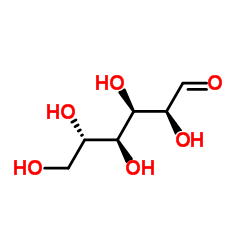L-Glucose

L-Glucose structure
|
Common Name | L-Glucose | ||
|---|---|---|---|---|
| CAS Number | 921-60-8 | Molecular Weight | 180.156 | |
| Density | 1.6±0.1 g/cm3 | Boiling Point | 527.1±50.0 °C at 760 mmHg | |
| Molecular Formula | C6H12O6 | Melting Point | 153-156ºC(lit.) | |
| MSDS | USA | Flash Point | 286.7±26.6 °C | |
|
Oncostatin-M differentially regulates mesenchymal and proneural signature genes in gliomas via STAT3 signaling.
Neoplasia 17(2) , 225-37, (2015) Glioblastoma (GBM), the most malignant of the brain tumors is classified on the basis of molecular signature genes using TCGA data into four subtypes- classical, mesenchymal, proneural and neural. The mesenchymal phenotype is associated with greater aggressiv... |
|
|
Preparation and testing of a Vi conjugate vaccine using pneumococcal surface protein A (PspA) from Streptococcus pneumoniae as the carrier protein.
Vaccine 32(43) , 5755-60, (2014) In the current study pneumococcal surface protein A (PspA) was conjugated to Vi capsular polysaccharide from Salmonella Typhi to make available a vaccine against typhoid fever that has the potential to also provide broad protection from Streptococcus pneumoni... |
|
|
Structure and bioactivity of a polysaccharide extracted from protocorm-like bodies of Dendrobium huoshanense.
Int. J. Biol. Macromol. 72 , 664-72, (2014) The crude polysaccharides of Dendrobium huoshanense were fractionated by anion-exchange chromatography and gel permeation chromatography, giving one homogeneous fraction DHP-4A with molecular weight of 2.32 × 10(5)Da. UV spectrum indicated that there was no e... |
|
|
Multilayered thin films from poly(amido amine)s and DNA.
Acta Biomater. 22 , 19-31, (2015) Dip-coated multilayered thin films of poly(amido amine)s (PAAs) and DNA have been developed to provide surfaces with cell-transfecting capabilities. Three types of PAAs, differing in side chain functional groups, were synthesized and characterized for their p... |
|
|
Investigation of cytotoxicity of phosphoryl choline modified single-walled carbon nanotubes under a live cell station.
Biomed Res. Int. 2014 , 537091, (2014) Single-walled carbon nanotubes (SWCNTs) and various modified SWCNTs have drawn a lot of attention due to their potential applications in biomedical field. Before further moving on to real clinical applications, hydrophobicity and toxicity of SWCNTs should be ... |
|
|
High glucose-induced intestinal epithelial barrier damage is aggravated by syndecan-1 destruction and heparanase overexpression.
J. Cell. Mol. Med. 19 , 1366-74, (2015) Syndecan-1 (Sdc1) and its endo-beta-D-glucuronidase heparanase (HPSE) are implicated in maintenance of intestinal epithelial barrier (IEB), but their alterations and roles in high-glucose/hyperglycaemia (HG) conditions have not been fully investigated. This s... |
|
|
Hydroxycarboxylic acid receptors are essential for breast cancer cells to control their lipid/fatty acid metabolism.
Oncotarget 6 , 19706-20, (2015) Cancer cells exhibit characteristic changes in their metabolism with efforts being made to address them therapeutically. However, targeting metabolic enzymes as such is a major challenge due to their essentiality for normal proliferating cells. The most succe... |
|
|
Electric Pulse Stimulation of Myotubes as an In Vitro Exercise Model: Cell-Mediated and Non-Cell-Mediated Effects.
Sci. Rep. 5 , 10944, (2015) Regular exercise has emerged as one of the best therapeutic strategies to prevent and treat type-2-diabetes. Exercise-induced changes in the muscle secretome, consisting of myokines and metabolites, may underlie the inter-organ communication between muscle an... |
|
|
Combinatorial regulation of a signal-dependent activator by phosphorylation and acetylation.
Proc. Natl. Acad. Sci. U. S. A. 111(48) , 17116-21, (2014) In the fasted state, increases in catecholamine signaling promote adipocyte function via the protein kinase A-mediated phosphorylation of cyclic AMP response element binding protein (CREB). CREB activity is further up-regulated in obesity, despite reductions ... |
|
|
Transition metals activate TFEB in overexpressing cells.
Biochem. J. 470 , 65-76, (2015) Transition metal toxicity is an important factor in the pathogenesis of numerous human disorders, including neurodegenerative diseases. Lysosomes have emerged as important factors in transition metal toxicity because they handle transition metals via endocyto... |